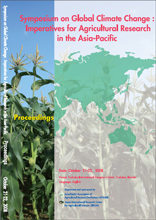Climate Change and Challenges in the Dry Areas

Dry areas cover 41% of the earth’s surface, and are home to over 2 billion people ? and the
majority of the world’s poor. Over 80% of the population in these regions lives on less than $2/day,
most of which is spent on food. Correspondingly, food insecurity ? exacerbated by the current food
crisis ? is perhaps the key challenge facing communities as well as governments in dry areas. Several
factors, some long-standing, others fairly recent, have contributed to the food crisis in dry areas. This
situation is further aggravated by the fragile nature of these environments, and the impacts (e.g.
extreme weather conditions already being experienced) of climate change.
Improving food security and livelihoods of the resource poor in these areas requires an
integrated approach based on the three pillars of sustainable agriculture: crop and livestock
improvement, natural resource management, and development of policies and institutional capacity.
Technology options for crop/livestock improvement and natural resource management are available.
But for these technologies to make a positive impact, supportive policies and effective technology
transfer are needed, which in turn requires stronger institutions. Policy makers must provide
incentives to encourage farmers to invest in new technologies. Simultaneously, they must ensure
long-term investment in research to maintain a flow of new technologies.
Numerous case studies have illustrated the importance of an integrated approach in improving
food security and livelihoods. For the past three decades ICARDA has worked towards sustainable
agricultural development in the dry areas, i.e. increasing productivity and production and improved
livelihood options for resource-poor farmers. Working in collaboration with the Center, national
programs have released nearly 850 improved varieties of wheat, barley, lentil, chickpea and faba bean
adapted to the dry areas. Recent successes include 'Alemaya', a rust-resistant lentil variety in
Ethiopia, and 'Gokce', a drought tolerant chickpea variety in Turkey, which have had major impacts in
these two countries. Integrated fungal and insect pest management techniques have cut production
costs and protected the environment. High value crops and protected agriculture are now available to
farmers in Afghanistan and Yemen to diversify production systems, and improve nutrition and
livelihoods. The Center has introduced improved crop management methods: more efficient water
management (e.g. water harvesting, supplemental irrigation), as well as conservation agriculture to
increase rainwater infiltration, raise yields, reduce production costs and protect the soil.
Continued investment in agricultural research will be the key to improving food security, cutting
food prices, and developing the capacities of national research centers to help farmers cope with
climate change. We believe this investment deserves the full support of the international community.
| Date of issued | |
|---|---|
| Creator | Mahmoud Solh Maarten van Ginkel |
| Publisher | Japan International Research Center for Agricultural Sciences |
| Available Online | |
| Issue | 2008 |
| spage | 128 |
| epage | 135 |
| Rights | Japan International Research Center for Agricultural Sciences |
| Language | eng |
